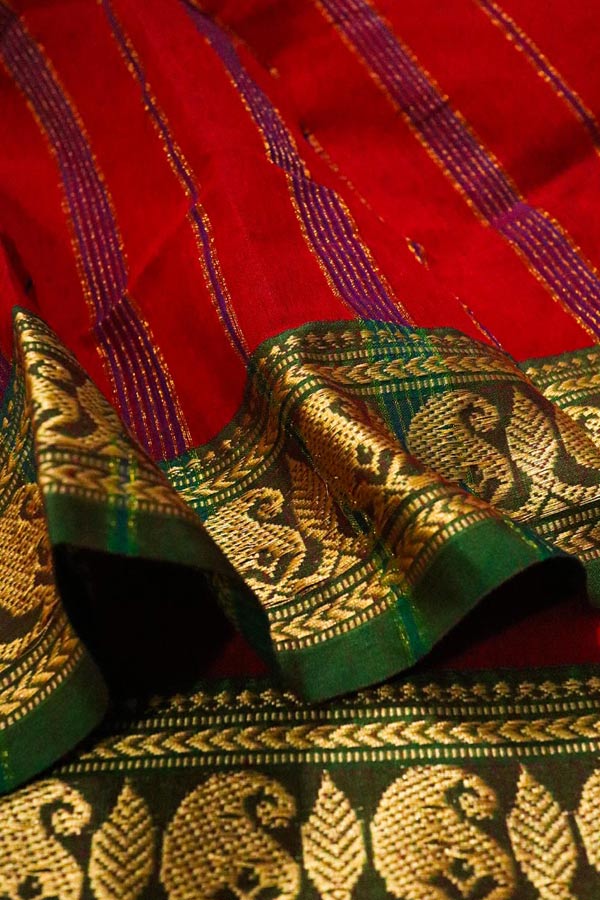Narayanpet Sarees traditionally are woven in and around the Sholapur district of Maharashtra and in many villages of Telangana. These are made in cotton and silk and has contrasting zari motifs on pallu and border. They are known for their lightweight, affordability, low maintenance and durability.
History of Narayanpet Sarees
When looking at history, the origin of the Narayanpet sarees can be traced back to 1630 AD, during Chatrapati Shivaji’s reign. There is a village named Narayanpet in Andhra Pradesh; it was under Chatrapati Shivaji’s rule then. Once, while travelling across the Narayanpet region, he decided to set his camp there. He resumed his travel after camping for a few days, but he left a few weavers behind. These weavers settled down in this village and started producing silk sarees. These sarees have a distinct style of design and came to be known as Narayanpet Silk sarees. Since the weavers had come from Maharashtra, a lot of Maharashtrian influence is seen on these sarees.
The production of these sarees flourished and the popularity reached its peak during the reign of Lokapalli Samasthanam.
Narayanpet is in the Mahabubnagar district of Telangana, bordering the Yadgir or Gulbarga districts of Karnataka, a small town with about 50,000 people. This place has extreme weather conditions, too hot in summers and cold in winters, thus giving birth to this comfortable fabric.
As people are staying here from various regions, there is a lot of Kannada, Telegu and Marathi influence on this saree. The colours are rich, the golden borders are lustrous and rich and the motifs are very traditional.
What is the Art and The Production of Narayanpet Sarees?
Material used
The sarees are majorly made of cotton and silk yarns. Both, the warp and the weft yarn are either cotton or silk. Sometimes, they are made with a combination of both silk or cotton yarns, where the warp is made of pure silk and the weft is made of cotton.
These sarees are made of fine cotton whose thread count is at least 80 and twisted silk yarns of only 18/20 thickness. The cotton yarns are obtained from the mills in Vijayawada and the nearby localities whereas, the silk yarns are brought from Bangalore. The gold zari is brought from Surat, which is a famous place for zari making in India.
Production
The process of producing the Narayanpet sarees is very traditional and unique. They weave 8 Narayanpet sarees in one go. Therefore, instead of mounting 7 yards of yarns on the loom, they mount 56 yards of yarn at a single time and work on them as a community.
- The silk goes through the degumming process, making it lighter and suitable for weaving.
- After all the processes like degumming, dyeing and drying, the actual weaving begins. It takes about one day to finish a cotton saree and about four to five days to finish a silk saree.
- The whole weaving process is done by hand on pre-set looms and no machines are used.
- A dobby loom is used only for the border, suitable threads and zari are wound on the loom.
- The zari is used in a shuttle to make the pallu. First, the zari is wound on a bobbin and then it is wound on a Kandi. Then the Kandi is fixed in a shuttle and it is ready to be used for weaving the pallu.
Borders, Motifs and Colours
The saree has small motifs made with zari on the border. Common motifs that can be seen on the border designs are mango, swan, leaf etc.
When talking about motifs, the regular wear Narayanpets do not feature any motifs on the body. The occasion wear sarees or the ones offered in the temples may have some motifs on them. However, intricate ethnic designs like temples and more can be seen on the pallu of these sarees. This contrast in the border and the pallu designs exist to make them unique.
The cotton sarees are usually plain and may have coloured checks on the body, it gives them an ethnic look. Whereas the Narayanpet silk sarees have a distinct style, they have Patti borders and Topa-Tenni pallus. The borders are flat-expanse in the chocolate red or deep maroon colours, finely separated by coloured or white lines. The sarees come with simple borders and special pallus in contrasting colours. They come in colour combinations like royal blue and cherry pink, turmeric yellow and kumkum red, sea blue and purple, mustard and black, emerald green and canary yellow etc.
The temple designs and the Topa-Tenni pallu are seen in the Narayanpet silk sarees and not the cotton variant.
How to Maintain Narayanpet Sarees?
- Unlike most silk saree, Narayanpet silk sarees are easier to take care of.
- For routine wash or to get rid of minor blemishes, one needs to wash it in normal water with mild detergent.
- It is recommended to avoid using a brush as that might damage and break the threads and zari.
- For major stains, it is better to send the saree for dry cleaning.
- These sarees should be dried in shade to avoid any decolouration or fading.

